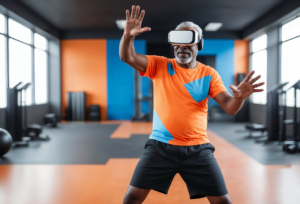The Metaverse is not just something of the future. It is rapidly progressing towards becoming our reality, merging the physical and virtual realms. The latter proposes an intended level of interaction for sports fans that will be unachievable. The latter is about watching your team from your comfortable armchair and in the stadium with millions of fans around you. The virtual world will likely revolutionize the concept of live sports as we know it.
The Metaverse Explained
The Metaverse is the internet space where people can communicate and surround themselves in a virtual reality. It is built with modern solutions such as virtual world headsets, blockchain, AI, and others to alter how people experience reality. The options of today’s betting platforms can extend the opportunities. They offer odds and engage the fans, allowing them to observe the games more closely. With a Melbet promo code, you can reveal many opportunities. The latter enriches your experience, whether you are betting from the comfort of a stadium or your home.
In the context of live exercise, this implies developing new patterns of interacting with favored teams for the supporters. While a ‘normal’ fan would sit and watch a game on TV, a metaverse fan can enter a digital stadium and watch the match with other like-minded digital citizens. Meeting other fans or having the opportunity to select the angle of the game they prefer – in reality, none of it would be possible.
Present-day live sporting events are still based on television coverage and physical presence in sports arenas. Furthermore, betting has shifted with this digital shift, as social media pages offer tips and odds at a glance. You can get in-depth predictions and analysis to enhance your experience, making every moment even more engaging, following on: https://www.facebook.com/groups/381879567540312
Current State of Live Sports
As much as these formats continue to be in fashion, they bear some drawbacks, particularly concerning the fans and how they are reached. Key limitations include:
- Limited viewing perspectives compared to in-person experiences.
- Physical attendance is constrained by ticket availability and location.
- Lack of interactive elements during broadcasts.
These factors leave room for innovation, and the Metaverse could be the next big step in bridging those gaps for a global audience.
Enhancing Live Sports Through the Metaverse
The Metaverse will enormously impact live sports by incorporating natural and virtual environments. This transition will change how fans view the games and how they can interact with them, providing a new channel of interaction.
Immersive Viewing Experiences
Specifically, fans can sit in the game and ‘watch’ live games from their homes as if in the stadium. VR headsets allow for more points of view, some from the player’s helmet or camera on the goalpost, to name a few. Fans who watch the game can also get live statistical updates and highlights and touch virtual reality directly. Consider the experience of watching the game and then calling instant replays or seeing on-the-field player stats – all of which show possibilities that are an extension of live sports.
Global Accessibility and Interaction
The Metaverse will also bring fans with different geographical affiliations together and develop a virtual football arena where fans are indifferent to their location. For instance, those in Europe or Asia can experience the natural feel of live games via the virtual realm with other enthusiasts.
Imagine a future where every sports fan has a virtual character, enhancing their social representation. Viewers can do more than just watch the game-they can clap, discuss the match, or even place bets, creating global audiences and communities. This potential of the Metaverse makes sports more accessible than ever, opening up exciting possibilities for the future.

Challenges and Considerations
Solving several challenges for the Metaverse will improve the live sports world. These hurdles include:
- Technological Barriers: We can confidently say that only some fans have costly equipment to function in the VR or AR world.
- Digital Infrastructure: The one area that needs to be most disciplined is the connection to the Internet, particularly when establishing a virtual classroom.
- User Adoption: Challenging fans to switch from physical means of viewing is one of the biggest tasks that can be daunting and needs to be accomplished with due diligence.
Overcoming these challenges is a must for the Metaverse to be fun for all, and for live sports to take the next step.
Future Predictions and Developments
For live sports, the Metaverse future is as rosy as ever could be painted. In the future, with advancements in technology, it will be easier to integrate virtual reality because it enables fans to play games in an unexplained way. On the other hand, by using high-end haptics, it is possible to have people feel what it is like to be in a stadium and go through hooligans, the sound of the ball touching the post,
Furthermore, the ongoing evolution of AI presents a promising future. The ability to analyze games and focus on player details and attitudes in real time are a game-changing innovation. These advancements will transform how fans experience their favorite sports, making virtual fans feel right in the stadium.
Final Thoughts
The Metaverse has yet to impact the live sports segment and its commercial strategies. However, these concerns can be part of how one looks at organized sports and how fans across the globe interact with them. As to the future, when technology is further improved, it will perhaps be as entertaining to watch as perform.




